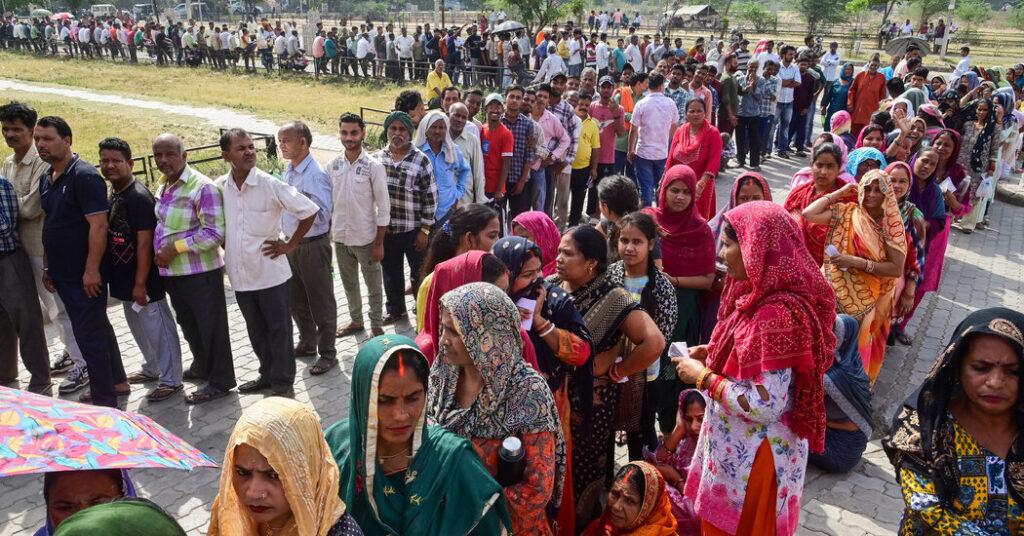India’s six-week general election, a referendum on Prime Minister Narendra Modi’s decade in power, ended on Saturday as much of the country’s densely populated north was hit by a deadly heatwave.
Results will be tallied and announced on Tuesday.
Modi, who is entrenched in power, is considered likely to serve as prime minister for a third consecutive term, which would make him only the second leader in India’s nearly 75 years of existence to achieve such a feat.
But the newly united opposition has launched a fight against Modi’s divisive politics and management of India’s deeply unequal economic growth. The country will now wait and see whether the opposition can achieve its goal of slashing the outright majority held by Modi’s Hindu nationalist Bharatiya Janata Party (BJP) in parliament.
The election, held in stages over a month and a half, is the world’s largest democratic election, with more than 950 million eligible voters. The final stretch of the campaign drew massive rallies even as northern India was scorched by an intense heat wave, with temperatures regularly exceeding 110 degrees Fahrenheit (43 degrees Celsius).
At least 19 poll workers have died in recent days from heat stroke or other health complications caused by the heat.
Elections in a parliamentary system like India’s are usually conducted on a seat-by-seat basis, with the fate of candidates depending on local economic and social factors. But the BJP turned its 543-seat parliamentary campaign into a presidential-style referendum, focusing the focus almost entirely on Modi and his leadership. The party hopes Modi’s broad support will help it overcome rising anti-incumbency sentiment after a decade in power under the Bharatiya Janata Party.
In more than two months of campaigning, Modi held about 200 rallies across the country in hopes of boosting his party’s embattled candidates. He also went on a media blitz, granting interviews to some 80 television stations and newspapers, nearly all of which were favorable to him.
With the campaign winding down and a mandatory two-day electoral pause about to begin, Modi retreated south to a monument to India’s most famous monk for two days of meditation. Domestic media followed suit. His office sparked debate on the evening news and on television by releasing a series of videos and photos taken from multiple angles in locations where photography is not usually allowed.
Modi’s opponents loudly said the exercise amounted to a ban on campaigning and reflected the unfair playing field he had created.
“The weather is nice. The prime minister is sitting there meditating and he is softening the sun goddess,” actor and BJP candidate Ravi Kishan told local media. “It’s historic – in the heat, the wind started to pick up today.”
The opposition has been beset by arrests and other punitive actions as part of the crackdown but has still rallied to its most united front in years. Opposition leaders have portrayed Modi as a friend of billionaires who have struggled to create jobs for the country’s vast youth population. They call his party elitist and accuse it of failing to elevate the lower and middle ranks of India’s caste system.
The opposition has stoked fears that if the BJP remains in power, it could amend the country’s constitution to scrap affirmative action for lower and middle castes, a decades-old effort to address several issues in India’s hierarchical society. A system developed over centuries of oppression.
Mr Modi has strongly denied the accusations as baseless; his party has increased its outreach to lower castes. To maintain unity among his Hindu support base, he has turned to anti-Muslim rhetoric, launching what has been an unusually direct attack on him in recent years.
The opposition is also trying to win over voters by promising a range of welfare measures, including loan forgiveness for farmers, cash transfers for women and paid apprenticeships for young people. Modi, on the other hand, stuck to his image of fiscal prudence and emphasized only his existing policies. His party members say that’s because he’s confident of winning a third term and doesn’t want to make too many promises.
But while the opposition appears to be gaining some support, it still faces an uphill task in overthrowing Modi’s government. He built a huge electoral advantage with a powerful and well-financed political machine. In the last election, Modi’s party won 303 seats, almost six times more than its nearest national rival, the Indian National Congress.
Pragati Knowledge Base Reporting from Comorin, India.

